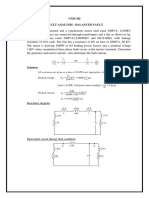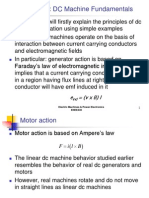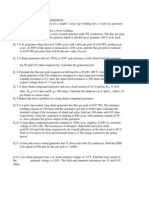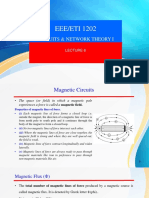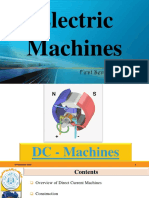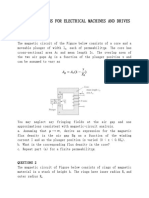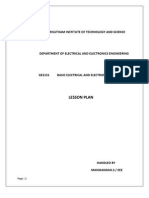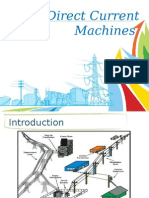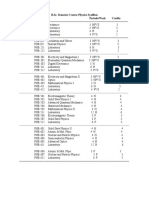DC Machinery Fundamentals
DC Machinery Fundamentals
Uploaded by
Jagabandhu KarCopyright:
Available Formats
DC Machinery Fundamentals
DC Machinery Fundamentals
Uploaded by
Jagabandhu KarCopyright
Available Formats
Share this document
Did you find this document useful?
Is this content inappropriate?
Copyright:
Available Formats
DC Machinery Fundamentals
DC Machinery Fundamentals
Uploaded by
Jagabandhu KarCopyright:
Available Formats
EEEB283 Electrical Machines and Drives DC Machinery Fundamentals
_____________________________________________________________________
1
Dr. Ungku Anisa, UNITEN 2006
Chap. 8: DC Machinery Fundamentals
This chapter will firstly explain the principles of dc machine
operation using simple examples before considering some of the
complications that occur in real dc machines.
8.1. A simple rotating loop between curved pole faces
The simplest rotating dc machine is shown below.
It consists of:
A rotating single loop of wire in a slot carved in a
cylindrical ferromagnetic core rotor
A pair of magnetic poles (north and south) stator
The magnetic field is supplied by the stator, i.e. N and S poles.
The air gap between the rotor and stator is of constant width
(i.e.
gap
is the same everywhere under the pole faces).
magnetic flux density is constant everywhere
under the pole surface.
From Chapter 1, we know that
iron gap
>> , hence
magnetic flux takes shortest possible path through
the air gap (i.e. perpendicular to the rotor surface).
EEEB283 Electrical Machines and Drives DC Machinery Fundamentals
_____________________________________________________________________
2
Dr. Ungku Anisa, UNITEN 2006
The voltage induced in a rotating loop
If the rotor is rotated, a voltage will be induced in the wire
loop. (Note: No voltage source applied to the rotor terminals.)
To determine the total voltage e
tot
on the loop, each segment of
the loop (as shown in the figure above) has to be examined
separately and the resulting voltages summed up (see page 33).
The voltage on each segment is given by ( ) l B v e
ind
r r
r
=
Hence, the total induced voltage in the loop:
=
+ + + = =
edges pole the beyond 0
faces pole under the 2vBl
e
e e e e e e
ind
ad dc cb ba tot ind
When the loop rotates through 180 ,
segment ab is under the north pole instead of the south
pole
direction of e
ba
and e
dc
but magnitude
remains constant
(8.1)
Top and front view of the simple dc machine
EEEB283 Electrical Machines and Drives DC Machinery Fundamentals
_____________________________________________________________________
3
Dr. Ungku Anisa, UNITEN 2006
The resulting voltage e
tot
is shown in the figure below.
An alternative expression for e
ind
that relates the behaviour of
the single loop to the behaviour of larger, real dc machines can
be obtained by examining the figure below:
The tangential velocity v of the loop edges can be expressed as v
= r. Therefore,
=
edges pole the beyond 0
face pole under the 2 Bl r
e
ind
Output voltage of the simple dc machine
Derivation of an alternative form of induced voltage equation.
EEEB283 Electrical Machines and Drives DC Machinery Fundamentals
_____________________________________________________________________
4
Dr. Ungku Anisa, UNITEN 2006
For a 2-pole machine, if we assume that the gap between the
poles is negligible (the gaps at the top and bottom of the
diagram) then the surface area of the pole can be written as
rl
rl
A
P
= =
2
2
Therefore,
=
edges pole the beyond 0
face pole under the
2
B A
e
P
ind
Since the air gap flux density B is constant everywhere under
the pole faces, the total flux under each pole is:
B A
P
=
Thus, the final form of the voltage equation is:
=
edges pole the beyond 0
face pole under the
2
ind
e
In general, the voltage in any real machine will depend on the
same three factors:
the flux in the machine
the speed of rotation
a constant representing the machine construction
Getting DC voltage out of the rotating loop
The voltage out of the loop is alternating between a constant
positive value and a constant negative value, i.e. ac voltage.
How can this machine be modified to produce a dc voltage?
(8.2)
EEEB283 Electrical Machines and Drives DC Machinery Fundamentals
_____________________________________________________________________
5
Dr. Ungku Anisa, UNITEN 2006
By using a mechanism called commutator and brushes
(see below)
two semicircular conducting segments (commutator
segments) are added to the end of the loop
two fixed contacts (brushes) are placed at an angle such
that at the instant the voltage in the loop is zero, the
contacts short-circuit the two segments
Every time voltage of the loop changes direction, the
contacts also switch connections and the output of
the contacts is always built up in the same way (as
shown below).
This connection-switching process is known as
.
Output voltage of a dc
machine with
commutator and brushes.
EEEB283 Electrical Machines and Drives DC Machinery Fundamentals
_____________________________________________________________________
6
Dr. Ungku Anisa, UNITEN 2006
The induced torque in the rotating loop
If the simple machine is connected to a battery, as shown below,
how much torque will be produced in the stationary loop
when the switch is closed and current is allowed to flow?
As before, the approach is to examine each segment of the loop
and then sum the effects of all segments (see page 34).
The force on each segment is given by ( ) B l i F
r r r
= .
And the torque on the segment is given by
sin rF F r T = =
r
r
, where is the angle between r
r
and F
r
.
When the loop is beyond the pole edges, T = 0 (since B
r
= 0).
The simple dc
machine
connection for
derivation of
induced torque
equation.
Front view of
the machine
(the iron core
is omitted for
clarity).
EEEB283 Electrical Machines and Drives DC Machinery Fundamentals
_____________________________________________________________________
7
Dr. Ungku Anisa, UNITEN 2006
Hence, the total induced torque in the loop is:
=
+ + + = =
edges pole the beyond 0
faces pole under the 2rilB
T
T T T T T T
ind
da cd bc ab tot ind
By employing the facts that rl A
P
and B A
P
= , the torque
expression can be reduced to:
=
edges pole the beyond 0
face pole under the
2
i
T
ind
In general, the torque in any real machine will depend on the
same three factors:
the flux in the machine
the current in the machine
a constant representing the machine construction
(8.3)
(8.4)
EEEB283 Electrical Machines and Drives DC Machinery Fundamentals
_____________________________________________________________________
8
Dr. Ungku Anisa, UNITEN 2006
EEEB283 Electrical Machines and Drives DC Machinery Fundamentals
_____________________________________________________________________
9
Dr. Ungku Anisa, UNITEN 2006
commutators
EEEB283 Electrical Machines and Drives DC Machinery Fundamentals
_____________________________________________________________________
10
Dr. Ungku Anisa, UNITEN 2006
8.2. Commutation in a simple four-loop DC machine
(see page 35 for the detailed explanation)
The resulting terminal voltage as a function of time is shown
below:
Note: this is a better approximation to a constant dc level than
that produced by the single rotating loop of Section 8.1.
As the number of loops on the rotor increases, the
approximation to a perfect dc voltage gets better and better.
In summary:
Commutation is the process of switching the loop connections
on the rotor of a dc machine just as the voltage in the loop
switches polarity, in order to maintain an essentially constant
dc output voltage.
Commutator segments = rotating segments to which the loops
are attached. Typically made of copper bars.
Brushes = stationary pieces that ride on top of the moving
segments. Typically made up of a mixture containing graphite,
so that they cause very little friction.
The resulting output voltage of the four-loop two-pole dc machine.
EEEB283 Electrical Machines and Drives DC Machinery Fundamentals
_____________________________________________________________________
11
Dr. Ungku Anisa, UNITEN 2006
8.3. Commutation and armature construction in real DC
machines
In real dc machines, there are several ways in which the loops
on the rotor (also called the armature) can be connected to its
commutator segments.
These different connections affect:
Number of parallel current paths within the rotor
The output voltage of the rotor
Number and position of the brushes riding on he
commutator segments
The rotor coils
Regardless of the way the
windings are connected to the
commutator segments, the rotor
windings consist of diamond-
shaped preformed coils which
are inserted into the armature
slots as a unit (see figure).
Each coil consists of a number
of turns (loops) of wire, each turn taped and insulated from
the other turns and from the rotor slot.
Each side of a turn is called a conductor and the number of
conductors on a machines armature is given by:
c
CN Z 2 =
where Z = number of conductors on rotor
C = number of coils on rotor
N
c
= number of turns per coil
Normally, a coil spans 180 electrical degrees. This means that
when one side is under the centre of a given magnetic pole, the
other side is under the centre of a pole of opposite polarity.
(8.8)
The shape of a
typical
preformed
rotor coil.
EEEB283 Electrical Machines and Drives DC Machinery Fundamentals
_____________________________________________________________________
12
Dr. Ungku Anisa, UNITEN 2006
The physical poles may not be 180 mechanical degrees apart
but the magnetic field has completely reversed its polarity in
travelling from under one pole to the next.
The relationship between the electrical angle and mechanical
angle in a given machine is given by:
m e
P
2
=
where
e
= electrical angle, in degrees
m
= mechanical angle, in degrees
P = number of magnetic poles on the machine
If a coil spans 180 electrical degrees, the voltages in the
conductors on either side of the coil will be exactly the same in
magnitude but opposite in direction at all times. Such a coil is
called a full-pitch coil.
A fractional-pitch coil spans less than 180 electrical degrees,
and a rotor winding wound with fractional-pitch coils is called a
chorded winding.
The amount of chording in a winding is described by a pitch
factor p, defined by:
% 100
180
coil of angle electrical
= p
Most rotor windings are two-layer windings, meaning that sides
from two different coils are inserted into each slot. One side of
each coil will be at the bottom of its slot, and the other side will
be at the top of its slot.
(8.9)
(8.10)
EEEB283 Electrical Machines and Drives DC Machinery Fundamentals
_____________________________________________________________________
13
Dr. Ungku Anisa, UNITEN 2006
Connections to the commutator segments
There are a number of ways in which the rotor windings can be
connected to the commutator segments. The different winding
arrangements have different advantages and disadvantages.
Commutator pitch y
c
= distance (in number of segments)
between the commutator segments to which the two ends of a
coil are connected.
Progressive winding (y
c
=1) =
the end of a coil (or a set number
of coils) is connected to a
commutator segment ahead of
the one its beginning is
connected to.
Retrogressive winding ( y
c
=-1)
= the end of a coil (or a set
number of coils) is connected to
a commutator segment behind
the one its beginning is
connected to.
If everything else is identical, the rotation direction of a
progressive-wound rotor is opposite to that of a retrogressive-
wound rotor.
Rotor (armature) windings are further classified according to the
plex of their windings:
1. A simplex rotor winding is a single, complete, closed
winding wound on a rotor.
2. A duplex rotor winding is a rotor with two complete and
independent sets of rotor windings. Each of the windings
will be associated with every other commutator segment:
one winding will be connected to segments 1, 3, 5, etc.,
A coil in a progressive winding. A coil in a retrogressive winding.
EEEB283 Electrical Machines and Drives DC Machinery Fundamentals
_____________________________________________________________________
14
Dr. Ungku Anisa, UNITEN 2006
and the other winding will be connected to segments 2, 4,
6, etc.
3. A triplex winding will have three complete and
independent sets of windings, each winding connected to
every third commutator segment on the rotor.
4. All armature with more than one set of windings are called
multiplex windings.
Finally, armature windings are classified according to the
sequence of their connections to the commutator segments:
Lap winding
Wave winding
Frog-leg winding (combines lap and wave windings in a
single rotor)
Note: for individual characteristics, advantages and
disadvantages of these windings, please refer to Chapman
textbook page 493 502.
8.4. Problems with commutation in real machines
In practice, the commutation process is not as simple as
described theoretically in Sections 8.2 and 8.3. There are two
major effects that disturb the commutation process:
I. Armature reaction
II. L di/dt voltages
This section explores the nature of these problems and the
solutions employed to mitigate their effects.
EEEB283 Electrical Machines and Drives DC Machinery Fundamentals
_____________________________________________________________________
15
Dr. Ungku Anisa, UNITEN 2006
I. Armature reaction
In real DC machines, the magnetic field is provided by field
windings on the stator, i.e. no magnets.
If the magnetic field windings of a dc machine are connected
to a power supply and the rotor of the machine is turned by
an external source of mechanical power, then
a voltage will be induced in the conductors of the
rotor.
This voltage will be rectified into a dc output by the action of
the machines commutator.
When a load is connected to the terminals of the machine:
current will flow in its armature windings.
this current produces
which will distort the original magnetic field from the
machines poles
Armature reaction = of the flux in the
machine as the load is increased.
It causes two serious problems in real dc machines.
Problem 1: Neutral-plane shift
Magnetic neutral plane = the plane within the machine where
the velocity of the rotor is exactly parallel to the magnetic
flux lines, so that in the conductors in the plane.
To understand the problem of neutral plane shift, the two-pole
dc machine shown below is employed.
EEEB283 Electrical Machines and Drives DC Machinery Fundamentals
_____________________________________________________________________
16
Dr. Ungku Anisa, UNITEN 2006
The flux is distributed
uniformly under the pole
faces.
The rotor windings have
voltages built up as shown on
the left.
Hence, the neutral plane is
exactly vertical
.
Now suppose a load is connected such that the machine acts
as a generator (i.e. no power supplied to rotor windings).
Current flows out of the
positive terminal of the
generator, as shown on the
left.
This current flow produces a magnetic field from the rotor
windings, as shown in picture (c). (direction: right-hand rule)..
This rotor magnetic field affects the original magnetic field
from the poles that produced the generators voltage in the
first place.
In some places under the
pole surfaces, it subtracts
from the pole flux.
In other places, it adds to
the pole flux.
EEEB283 Electrical Machines and Drives DC Machinery Fundamentals
_____________________________________________________________________
17
Dr. Ungku Anisa, UNITEN 2006
The overall result is that the
magnetic flux in the air gap of
the machine is skewed as
shown on the left.
Notice that the place on the rotor where induced voltage in a
conductor would be zero (i.e. the neutral plane) has
.
In a dc generator magnetic neutral plane shifts
the direction of rotation.
In a dc motor magnetic neutral plane shifts
to the direction of
rotation (due to reverse in rotor current
direction, hence flux add and subtract
at opposite corners from that shown in
picture (d) above).
Note: amount of shift depends on the machine load.
What is the effect of neutral-plane shift?
The brushes must short out commutator segments just at
the moment when the voltage across them is zero.
If the brushes are set to short out conductors in the vertical
plane, then the voltage between the segments is zero until
the machine is loaded.
When the machine is loaded, the neutral plane shifts and
the brushes short out commutator segments with finite
voltage across them.
EEEB283 Electrical Machines and Drives DC Machinery Fundamentals
_____________________________________________________________________
18
Dr. Ungku Anisa, UNITEN 2006
The result is:
Current flow circulating between the shorted segments
Large sparks at the brushes when the current path is
interrupted as the brush leaves the segment
End result: at the
brushes.
This is a very serious problem. It leads to:
Drastically reduced brush life.
Pitting of the commutator segments.
Greatly increased maintenance costs.
Notice that this problem cannot be fixed by placing the
brushes over the full-load neutral plane, as it will then cause
sparks at no load.
In extreme cases, the neutral-plane shift can lead to flashover
in the commutator segments near the brushes.
(The air near the burshes in a machine is normally ionized as a
result of sparking on the brushes. Flashover occurs when the
voltage of adjacent comutator segments gets large enough to
sustain an arc in the ionized air above them. If flashover occurs,
the resulting arc can even melt the commutators surface.)
Problem 2: Flux weakening
To understand flux weakening, refer to the magnetisation curve
shown below:
EEEB283 Electrical Machines and Drives DC Machinery Fundamentals
_____________________________________________________________________
19
Dr. Ungku Anisa, UNITEN 2006
Most machines operate near the saturation point (knee of
curve).
At locations on the pole surface where rotor mmf adds to the
pole mmf, only a small increase in flux occurs.
But at locations on the pole surface where rotor mmf
subtracts from the pole mmf, a decrease in
flux occurs.
The net result:
The total average flux under the entire pole face is
decreased (see figure below).
EEEB283 Electrical Machines and Drives DC Machinery Fundamentals
_____________________________________________________________________
20
Dr. Ungku Anisa, UNITEN 2006
Flux weakening causes problems in both generators and motors.
In generators, the effect is reduced voltage supplied by the
generator for any given load.
The flux-weakening effect can be more serious for motors:
when flux is decreased, its speed
but increase in motor speed can increase its load, resulting
in more flux weakening (hence, speed increase further)
it is possible for some shunt dc motors to reach
condition, where motor speed just keeps
on increasing until the machine is disconnected from the
power line or until it destroys itself.
EEEB283 Electrical Machines and Drives DC Machinery Fundamentals
_____________________________________________________________________
21
Dr. Ungku Anisa, UNITEN 2006
II. L di/dt voltages
The L di/dt voltages occur in commutator segments that are
being by the brushes.
Also sometimes known as inductive kick.
To understand this problem, refer to the figures below
representing a series of commutator segments (a, b, c, d ..) and
the conductors (or coils) connected to them.
Assuming that the current in the brush = 400A, the current in
each path is 200A (since current split into two coils).
When a commutator segment is shorted out, the current flow
through the commutator segment must reverse.
How fast must this reversal occur?
Assuming the machine is rotating at 800 rpm and that there are
50 commutator segments (a reasonable number for a typical
motor), each commutator segment moves under a brush and
clears it again in t = 0.0015s.
Calculations:
800 rpm = 83.78 rad/s
1 segment takes up 0.126 rad ( = 50 / 2 )
Time to clear 1 segment = 0.126 / 83.78 = 0.0015s
EEEB283 Electrical Machines and Drives DC Machinery Fundamentals
_____________________________________________________________________
22
Dr. Ungku Anisa, UNITEN 2006
Therefore, the rate of change in current with respect to time in
the shorted loop must average:
With even a tiny inductance L in the loop, a very significant
inductive voltage kick v = L di/dt will be induced in the shorted
commutator segment.
This high voltage naturally causes sparking in the brushes of
the machine, resulting in the same arcing problems as caused
by the neutral-plane shift.
Solution to the problems with commutation
The following three approaches have been developed to partially
or completely correct the problems of armature reaction and L
di/dt voltages:
I. Brush shifting
This method attempts to stop the sparking at the brushes caused
by the neutral-plane shifts and L di/dt effects.
A/s 667 , 266
s 0015 . 0
) 200 ( 200
=
=
dt
di
The current reversal in the
coil undergoing
commutation as a function
of time for both ideal and
real commutation, with the
coil inductance taken into
account.
ideal
commutation
real
commutation
- 200 A
EEEB283 Electrical Machines and Drives DC Machinery Fundamentals
_____________________________________________________________________
23
Dr. Ungku Anisa, UNITEN 2006
Since the neutral plane shifts, hence shift the brushes (to the
new neutral plane position) to stop the sparking.
But there are several serious problems associated with this
method:
The neutral plane moves with changes in load and the shift
direction reverses when going from motor to generator
operation.
Even though brush sparking is stopped, brush shifting
aggravates the flux-weakening effect of armature reaction
in the machine. This is true because of two effects:
i. The rotor mmf now has a vector component that opposes
the mmf from the poles (see figure below).
ii. The change in armature current distribution causes the
flux to bunch up even more at the saturated parts of the
pole faces.
However, this method is obsolete.
Before brush shifting (i.e.
brushes over the vertical plane)
After brush shifting (i.e. brushes
over the shifted neutral plane)
EEEB283 Electrical Machines and Drives DC Machinery Fundamentals
_____________________________________________________________________
24
Dr. Ungku Anisa, UNITEN 2006
It is only used in very small motors where other better solutions
are not economical.
II. Commutating poles or interpoles
Basic idea:
If the voltage in the wires undergoing commutation can be
made zero, then there will be no sparking at the brushes.
Method:
Small poles called commutating poles or interpoles are placed
midway between the main poles and directly
over the conductors being commutated.
The flux provided by the commutating poles will exactly
the voltage in the coils undergoing
commutation. Therefore,
there will be no sparking at the brushes.
The commutation poles do not change the operation of the
machine because they are so small and only have effect on the
few conductors undergoing commutation.
Hence, armature reaction under the main pole faces is
unaffected, i.e.
flux weakening in the machine is unaffected by
the commutating poles (i.e. flux weakening problem is
not resolved).
How is cancellation of voltage in the commutator segments
accomplishes for all values of load?
This is done by connecting the interpole windings in series
with the windings on the rotor.
EEEB283 Electrical Machines and Drives DC Machinery Fundamentals
_____________________________________________________________________
25
Dr. Ungku Anisa, UNITEN 2006
As the load increases
The rotor current (I
A
) increases
Magnitude of neutral plane shift
and
size of L di/dt effects increases
Increases voltage in conductors undergoing commutation
(which was supposed to be zero)
BUT
Interpole flux increases as well
(due to series connection, i.e. I
A
, I
interpole
)
Gives larger voltage in the conductor which
opposes voltage due to
the neutral-plane shift
The net result is:
Commutating pole cancels the neutral-plane
shift and L di/dt effects over a broad range of loads.
Note: Interpoles work for both motor and generator
operation.
A dc machine
with interpoles
EEEB283 Electrical Machines and Drives DC Machinery Fundamentals
_____________________________________________________________________
26
Dr. Ungku Anisa, UNITEN 2006
What polarity must the flux in the interpoles be?
Interpoles must induce voltage in the conductors undergoing
commutation that is opposite to the voltage caused by the
neutral-plane shift and L di/dt effects.
For a generator,
neutral-plane shifts in the direction of rotation.
conductors undergoing commutation have the same
voltage polarity as the pole they just left.
to cancel this effect:
Interpoles must be of the same polarity as the
next upcoming main pole in a generator.
For a motor,
reverse in rotor current direction compared to generator
mode
neutral-plane shifts opposite to the direction of rotation.
conductors undergoing commutation have the same
voltage polarity as the pole they are approaching.
to cancel this effect:
Interpoles must be of the same polarity as the
previous main pole in a motor.
Determining the required polarity
of an interpole. The flux from the
interpole must produce a voltage
that opposes the existing voltage in
the conductor.
EEEB283 Electrical Machines and Drives DC Machinery Fundamentals
_____________________________________________________________________
27
Dr. Ungku Anisa, UNITEN 2006
Use of commutating poles:
very common
they correct sparking problems at low cost
BUT flux-weakening problem is till present!
III. Compensating windings
Flux-weakening problem can be very serious in very heavy,
severe duty cycle motors.
Compensating windings are:
placed in slots carved in the faces of the poles parallel
to the rotor conductors.
Connected in series with the rotor windings such that
load changes will change the currents in the compensating
windings.
Figures below shows the basic concept of compensating
windings.
1. Here, the pole flux is shown
by itself.
2. The rotor flux and compensating
winding flux is shown.
3. The sum of the fluxes is just equal to the original pole flux
by itself.
EEEB283 Electrical Machines and Drives DC Machinery Fundamentals
_____________________________________________________________________
28
Dr. Ungku Anisa, UNITEN 2006
A more careful development of the compensating winding effect
is shown below:
Mmf due to compensating windings is equal and opposite
to the mmf due to the rotor at every point under the pole
surface.
The resulting net mmf is just the mmf due to the poles.
Flux in the machine is unchanged regardless of load.
The flux and magnetomotive forces in a dc machine with compensating
windings.
EEEB283 Electrical Machines and Drives DC Machinery Fundamentals
_____________________________________________________________________
29
Dr. Ungku Anisa, UNITEN 2006
The major disadvantage of compensating windings:
expensive must be machined into pole faces
does not cancel L di/dt effects also requires interpoles
8.5. Internal generated voltage and induced torque
equations for real DC machines
Internal generated voltage equation
The voltage out of the armature of a real machine is:
( )
( ) vBl
a
Z
E
E
A
A
=
|
\
|
= conductor each on voltage
path current per
conductors of number
where Z = total number of conductor
a = number of current paths
The velocity of each conductor in the rotor can be expressed as v
= r, where r is the radius of the rotor.
Therefore,
( ) Bl r
a
Z
E
A
=
Since the area per pole P rl A
P
2 = , hence the total flux per
pole in a P pole machine is:
B
P
rl
B A
P
2
= =
The voltage out of the armature of a real dc machine is:
(8.11)
(8.13)
(8.12)
( )
K E
a
ZP
P
rlB
a
ZP
rlB
a
Z
E
A
A
=
=
|
\
|
= =
2
2
2
EEEB283 Electrical Machines and Drives DC Machinery Fundamentals
_____________________________________________________________________
30
Dr. Ungku Anisa, UNITEN 2006
Induced torque equation
The torque on the armature of a real machine is:
( ) ( )
|
\
|
=
=
a
lB rI
Z T
T
A
ind
ind
conductor each on torque conductors of number
The flux per pole in the machine can be expressed as:
( )
P
rl B
B A
P
2
= =
Therefore, torque on the armature of a real dc machine is:
( )
A ind
A A ind
I K T
I
a
ZP
I rlB
a
Z
T
=
= =
2
8.6. The construction of DC machines
A simplified diagram of a dc machine is shown below.
(8.14)
(8.15)
EEEB283 Electrical Machines and Drives DC Machinery Fundamentals
_____________________________________________________________________
31
Dr. Ungku Anisa, UNITEN 2006
The physical structure of the machine consists of two parts:
o Stator, consists of :
- the frame, which provides physical support.
- pole pieces, which project inward and provides path
for the machine magnetic flux.
- pole shoes, i.e. the ends of the pole pieces that
spread out near the rotor surface for even flux
distribution.
- pole face, i.e. exposed surface of a pole shoe.
o Rotor
Air gap = distance between stator and rotor.
There are two principal windings on a dc machine:
o Armature windings windings in which voltage is
induced (i.e. rotor windings in the dc machine)
o Field windings windings that produce the main
magnetic flux in the machine (i.e. stator windings in the
dc machine)
Note: Since the armature windings are on the rotor, a dc
machines rotor is sometimes called an armature.
8.7. Power flow and losses in DC machines
The efficiency of a dc machine:
% 100 % 100 % 100
=
+
= =
in
loss in
loss out
out
in
out
P
P P
P P
P
P
P
EEEB283 Electrical Machines and Drives DC Machinery Fundamentals
_____________________________________________________________________
32
Dr. Ungku Anisa, UNITEN 2006
Losses in DC machines
1. Electrical or copper losses (I
2
R loss):
Armature loss:
A A A
R I P
2
=
Field loss :
F F F
R I P
2
=
2. Brush losses power loss across the contact potential at the
machine brushes.
Brush drop loss:
A BD BD
I V P =
3. Core losses hysteresis and eddy current losses occurring in
the metal of the motor.
4. Mechanical losses losses associated with mechanical
effects, i.e. friction and windage losses.
5. Stray losses (or miscellaneous losses) losses that cannot
be placed in any of the above categories.
The power flow diagram
For a dc motor:
P
out
= T
app
m
T
EEEB283 Electrical Machines and Drives DC Machinery Fundamentals
_____________________________________________________________________
33
Dr. Ungku Anisa, UNITEN 2006
8.1 A simple rotating loop between curved pole faces
Detailed segment analysis to obtain the voltage induced in a
simple rotating loop
Segment ab:
Velocity v
ab
tangential to rotation path
=
edges pole the beyond , 0
pole under the , surface to
B
r
=
edges pole the beyond , 0
face pole under the , page into positive vBl
e
ba
Segment bc:
direction of ( ) B v
r
r
either into or out of page
( ) l B v
r r
r
0 =
cb
e
Segment cd:
Velocity v
cd
tangential to rotation path
=
edges pole the beyond , 0
pole under the , surface to
B
r
=
edges pole the beyond , 0
face pole under the , page of out positive vBl
e
dc
Segment da:
( ) l B v
r r
r
0 =
ad
e
EEEB283 Electrical Machines and Drives DC Machinery Fundamentals
_____________________________________________________________________
34
Dr. Ungku Anisa, UNITEN 2006
Detailed segment analysis to obtain the torque induced in a
simple rotating loop
Segment ab:
Current directed out of the page
=
edges pole the beyond , 0
pole under the , surface to
B
r
=
edges pole the beyond , 0
face pole under the , direction motion o tangent t ilB
F
ab
r
=
edges pole the beyond , 0
face pole under the , ckwise counterclo rilB
T
ab
Segment bc:
Current flowing from upper left to lower right
( ) B l B l i F
bc
r r r r r
to parallel is since 0 = =
0 =
bc
T
Segment cd:
Current directed into the page
=
edges pole the beyond , 0
pole under the , surface to
B
r
=
edges pole the beyond , 0
face pole under the , direction motion o tangent t ilB
F
cd
r
=
edges pole the beyond , 0
face pole under the , ckwise counterclo rilB
T
cd
Segment da:
Current flowing from upper left to lower right
( ) B l B l i F
da
r r r r r
to parallel is since 0 = =
0 =
da
T
EEEB283 Electrical Machines and Drives DC Machinery Fundamentals
_____________________________________________________________________
35
Dr. Ungku Anisa, UNITEN 2006
8.2 Commutation in a simple four-loop DC machine
Commutation = process of converting the ac voltages
and currents in the rotor of a dc machine to dc voltages and
currents in its terminals.
A simple four-loop, two-pole dc machine (see figure below) has:
Four complete loops buried (in a special manner) in slots
carved in the laminated steel of the rotor.
Pole faces that are curved to provide uniform flux density
everywhere under the faces.
The unprimed end of each loop is the outermost wire
in each slot.
The primed end of each loop is the innermost wire in
the slot directly opposite.
The dc machine and its windings connection to the machines
commutator are shown below:
Notice that:
At t = 0 , in the dc machine:
The 1, 2, 3 and 4 ends of the loops are under the north
pole face and the voltage in each of the loop ends is given
by:
Loop
Stretches between
commutator
segments:
1 a and b
2 b and c
3 c and d
4 d and a
A four-loop two-pole dc machine at
time t = 0.
EEEB283 Electrical Machines and Drives DC Machinery Fundamentals
_____________________________________________________________________
36
Dr. Ungku Anisa, UNITEN 2006
( ) page of out positive vBl l B v e
ind
= =
r r
r
The 1, 2, 3 and 4 ends of the loops are under the south
pole face and the voltage in each of the loop ends is given
by:
( ) page the into positive vBl l B v e
ind
= =
r r
r
The overall result is shown below whereby each coil
represents
one side (or
conductor)
of a loop.
The total voltage at the brushes of the machine is:
= = 0 hen w 4 t e E
where e = vBl = induced voltage on one side of a loop.
Notice that there are two parallel paths for current through
the machine. The existence of two or more parallel paths
for rotor current is a common feature of all commutation
schemes.
(8.5)
The voltage on the
rotor conductors of a
four-loop two-pole
dc machine at time
t = 0.
EEEB283 Electrical Machines and Drives DC Machinery Fundamentals
_____________________________________________________________________
37
Dr. Ungku Anisa, UNITEN 2006
Figure below shows the machine at time t = 45 :
Loops 1 and 3 have rotated into the gap between the
poles, so the voltage across each of them is zero.
At this instant the brushes of the machine are shorting out
commutator segments ab and cd.
Only two loops 2 and 4 are under the pole faces, so the
terminal voltage E is given by:
= = 5 4 hen w 2 t e E
(8.6)
The same four-
loop two-pole dc
machine at time
t = 45.
The voltage on the
rotor conductors of
the dc machine at
time t = 45.
EEEB283 Electrical Machines and Drives DC Machinery Fundamentals
_____________________________________________________________________
38
Dr. Ungku Anisa, UNITEN 2006
The rotor continues to turn another 45, i.e. t = 90 :
The 1, 2, 3 and 4 ends of the loops are under the north
pole face and the voltage in each of the loop ends is given
by:
( ) page of out positive vBl l B v e
ind
= =
r r
r
The 1, 2, 3 and 4 ends of the loops are under the south
pole face and the voltage in each of the loop ends is given
by:
( ) page the into positive vBl l B v e
ind
= =
r r
r
The overall result is shown above on the right. The
terminal voltage of the machine is:
Note: The voltages on loops 1 and 3 have reversed between
t = 0 and t = 90, but their connections have also reversed.
Hence, the total voltage is still built up in the same direction as
before.
(8.7)
= = 0 9 when 4 t e E
The same two-pole dc machine at time t = 90 with the voltages on
the conductors.
You might also like
- Tutorial DC MachinesDocument2 pagesTutorial DC MachinesLucas LeeNo ratings yet
- Class - 15 - DC MotorsDocument24 pagesClass - 15 - DC MotorsHafsa Alhaddabi0% (1)
- Lecture Notes-Electrical Machine-II (BEE 1401) Part-I: Veer Surendra Sai University of Technology, BurlaDocument79 pagesLecture Notes-Electrical Machine-II (BEE 1401) Part-I: Veer Surendra Sai University of Technology, BurlaDeependra SinghNo ratings yet
- 1 - Introduction To Magnetic CircuitsDocument26 pages1 - Introduction To Magnetic Circuitsxenohjb100% (2)
- Unit PsaDocument14 pagesUnit Psasulthan_81100% (1)
- Basic Electronic ComponentsDocument23 pagesBasic Electronic ComponentsNilesh Jadhav100% (7)
- DC Machine PDFDocument35 pagesDC Machine PDFPulkit Kumar Chauhan92% (24)
- Ch8 DC Machine FundamentalsDocument29 pagesCh8 DC Machine FundamentalsalpizraNo ratings yet
- DC MachinesDocument44 pagesDC Machinesselvithimmarajan@gmail.comNo ratings yet
- DC MachineDocument124 pagesDC MachinejoebrislinNo ratings yet
- Lab 4 Study The Speed Characteristics of A Single Phase Asynchronous MotorDocument4 pagesLab 4 Study The Speed Characteristics of A Single Phase Asynchronous MotorAsim NoonNo ratings yet
- Exercise Problems On DC GeneratorsDocument2 pagesExercise Problems On DC GeneratorsSyed Arif Ahmed0% (1)
- DC Machine Example ProblemsDocument4 pagesDC Machine Example ProblemsFemi Prince50% (2)
- DC Machine CH 12 MotorDocument15 pagesDC Machine CH 12 MotorMakrand NavaleNo ratings yet
- DC MachinesDocument20 pagesDC MachinesRaeniel SoritaNo ratings yet
- Chap 7 Solutions PDFDocument34 pagesChap 7 Solutions PDFIbrahim Hussain100% (1)
- Lecture 6-Magnetic CircuitsDocument49 pagesLecture 6-Magnetic CircuitsMAENYA BRUCE OYONDINo ratings yet
- DC MachinesDocument48 pagesDC Machineskhed100% (2)
- Activity 3 Synchronous Motor PSDocument10 pagesActivity 3 Synchronous Motor PSReinz 0429No ratings yet
- Additional ProblemsDocument2 pagesAdditional ProblemsSubhasis MaityNo ratings yet
- DC Machines PDFDocument76 pagesDC Machines PDFAhmad Ali KhaderNo ratings yet
- Lecture1 Singly Excited SystemDocument79 pagesLecture1 Singly Excited SystemMuhammad Umar Ijaz86% (7)
- Transformer ProblemsDocument3 pagesTransformer ProblemsVaralakshmi SeerapuNo ratings yet
- Electrical MachinesDocument54 pagesElectrical MachinesAhmed MohamedNo ratings yet
- DC MachinesDocument34 pagesDC MachinesCristele Mae GarciaNo ratings yet
- EEE267 DCMotor Math ProblemsDocument5 pagesEEE267 DCMotor Math Problemsmaakbd100% (1)
- Syncronous Machine TUTDocument6 pagesSyncronous Machine TUTClaudioNo ratings yet
- ElectricalDocument157 pagesElectricalnaguNo ratings yet
- Review Questions For Electrical Machines and DrivesDocument14 pagesReview Questions For Electrical Machines and DrivesClifford Mkong100% (1)
- DC Generator Armature Windings)Document23 pagesDC Generator Armature Windings)zeshankhan4321_50832No ratings yet
- Electrical Machines BookDocument222 pagesElectrical Machines BookSUNILNo ratings yet
- Lesson Plan For BEEEDocument18 pagesLesson Plan For BEEEdineshanand810100% (1)
- Electrical Machines 2 Lab 2 UtechDocument11 pagesElectrical Machines 2 Lab 2 UtechDellonNo ratings yet
- AC Machines Alternators 2Document10 pagesAC Machines Alternators 2Vanvan BitonNo ratings yet
- CH-2-DC MachineDocument83 pagesCH-2-DC MachineÙm ØrthøbøyNo ratings yet
- Unit2 MachinesDocument35 pagesUnit2 MachinesdineshkumarNo ratings yet
- Electrical Machine Design Design 1: DC Generator Armature DesignDocument16 pagesElectrical Machine Design Design 1: DC Generator Armature DesignJ Arnold SamsonNo ratings yet
- Module Name:Electrical Machine I Module Code: Elt213: by AMAHIRWE Jean ClaudeDocument30 pagesModule Name:Electrical Machine I Module Code: Elt213: by AMAHIRWE Jean ClaudeOmar DjazzoNo ratings yet
- UNIT-1 DC Machines: ConstructionDocument54 pagesUNIT-1 DC Machines: ConstructionT.ThilagamaniNo ratings yet
- Chap 3 SolutionsDocument39 pagesChap 3 SolutionsFeliscio Ascione Felicio100% (1)
- Worked Examples For A Three - Phase Induction MachineDocument12 pagesWorked Examples For A Three - Phase Induction MachineAli AltahirNo ratings yet
- EM1 - Unit 1 NotesDocument37 pagesEM1 - Unit 1 NotesNIHAL GUPTANo ratings yet
- Tutorial Exercise On DC MachineDocument13 pagesTutorial Exercise On DC MachineTSEGAAB NIGUSSENo ratings yet
- DC MachinesDocument66 pagesDC MachinesNaga Raju AngajalaNo ratings yet
- DC MachinesDocument12 pagesDC MachinesLevhie Ceasar Raro Ragas Jr.50% (4)
- Ac Machines MCQDocument41 pagesAc Machines MCQnongdambaNo ratings yet
- Problem 11 Set A FinalDocument11 pagesProblem 11 Set A Finalmarktaborete0No ratings yet
- Tutorial Problems 32.3Document2 pagesTutorial Problems 32.3Grace Joy Romias50% (4)
- Lecture 8 DC Machines IIDocument15 pagesLecture 8 DC Machines IIMohamed HosamNo ratings yet
- Solving DC Motors Simple Torque Problems PDFDocument8 pagesSolving DC Motors Simple Torque Problems PDFRv EstebanNo ratings yet
- Eff and LossesDocument7 pagesEff and LossesOmil EstradaNo ratings yet
- EE 0 - SOLUTIONS DC MotorDocument9 pagesEE 0 - SOLUTIONS DC MotorHok HokNo ratings yet
- Chap 1 Single PhaseTransformerDocument37 pagesChap 1 Single PhaseTransformerKritika Mehta100% (1)
- Basic Concepts of Electrical EngineeringFrom EverandBasic Concepts of Electrical EngineeringRating: 5 out of 5 stars5/5 (1)
- DC MachineDocument33 pagesDC MachineJevon WilsonNo ratings yet
- Chapter 1Document40 pagesChapter 1TUMICAD, ZAIREN CNo ratings yet
- DC Generator TheoryDocument8 pagesDC Generator TheoryDeep Chowdhury100% (1)
- DC Machinery Fundamentals: DR Nadeem Iqbal KinpoeDocument62 pagesDC Machinery Fundamentals: DR Nadeem Iqbal KinpoeAdil MehmoodNo ratings yet
- 8 Speed Control Method of Induction MotoDocument12 pages8 Speed Control Method of Induction MotoJagabandhu KarNo ratings yet
- Automatic Street Light Control and FaultDocument6 pagesAutomatic Street Light Control and FaultJagabandhu KarNo ratings yet
- Smart Home Energy Management System Monitoring and Control of Appliances Using An Arduino Based Network in The Context of A Micro GridDocument69 pagesSmart Home Energy Management System Monitoring and Control of Appliances Using An Arduino Based Network in The Context of A Micro GridJagabandhu Kar0% (1)
- Smart GridDocument19 pagesSmart GridJagabandhu KarNo ratings yet
- 389 LanaDocument6 pages389 LanaJagabandhu KarNo ratings yet
- Mathematical Modelling& Various Control System Models & Responses Using MatlabDocument45 pagesMathematical Modelling& Various Control System Models & Responses Using MatlabJagabandhu KarNo ratings yet
- Scheme of Instruction and Examination B.Tech (Instrumentation Engineering)Document37 pagesScheme of Instruction and Examination B.Tech (Instrumentation Engineering)Jagabandhu KarNo ratings yet
- Unit V Design of Controllers For Drives: 3.1transfer Function For DC MotorDocument12 pagesUnit V Design of Controllers For Drives: 3.1transfer Function For DC Motormanoj kumarNo ratings yet
- BTech - 2019 Course Scse 1.1.1Document250 pagesBTech - 2019 Course Scse 1.1.1aurshiv123No ratings yet
- The Magnetic Field: OutlineDocument51 pagesThe Magnetic Field: Outlinenoor ul.mustafaNo ratings yet
- GGL Induksi Dan InduktansiDocument17 pagesGGL Induksi Dan InduktansiYudistira Ade saktipaNo ratings yet
- Answer: Q1. Three Types of DC Motor I. Series DC Motor Ii. Shunt DC Motor Iii. Compound DC MotorDocument5 pagesAnswer: Q1. Three Types of DC Motor I. Series DC Motor Ii. Shunt DC Motor Iii. Compound DC MotorMuhammad FitriNo ratings yet
- Technological Institute of The Philippines: Data and ResultsDocument6 pagesTechnological Institute of The Philippines: Data and Resultsjec_tanez100% (3)
- Final Course and Its ResourcesDocument35 pagesFinal Course and Its ResourcesBilal RazaNo ratings yet
- ContentsDocument9 pagesContentsTrung Kiên NguyễnNo ratings yet
- Presentation Magnetism 1594842079 208447Document10 pagesPresentation Magnetism 1594842079 208447Khilendra MandleNo ratings yet
- BiomagnetismDocument23 pagesBiomagnetismdeenish gaitundeNo ratings yet
- British Standard Non Magnetic Coating Substrates Measurement of Coating Thickness Magnetic Method (2178 1995)Document16 pagesBritish Standard Non Magnetic Coating Substrates Measurement of Coating Thickness Magnetic Method (2178 1995)Jorge SalasënNo ratings yet
- BSPH101 1st Sem.Document2 pagesBSPH101 1st Sem.upsclbsnaa2006No ratings yet
- Idee Per Una Lezione Digitale: La Corrente IndottaDocument4 pagesIdee Per Una Lezione Digitale: La Corrente IndottaLuis SandovalNo ratings yet
- EEC 123 Theory - Electrical Machines IDocument98 pagesEEC 123 Theory - Electrical Machines Idamigoodness43No ratings yet
- Magnetic Properties of Transition Metal ComplexesDocument12 pagesMagnetic Properties of Transition Metal ComplexesNikita SharmaNo ratings yet
- DCMotor Definition, Working, Types, AndFAQs 1675260129902Document16 pagesDCMotor Definition, Working, Types, AndFAQs 1675260129902Jafar EarlNo ratings yet
- BSC Physics Syllabus PDFDocument39 pagesBSC Physics Syllabus PDFFaizan KhanNo ratings yet
- 3D Full-Maxwell Simulations of Very Fast Transients in GISDocument4 pages3D Full-Maxwell Simulations of Very Fast Transients in GISaldian ekaNo ratings yet
- Sem QuestionsDocument11 pagesSem QuestionsRojaNo ratings yet
- Assignment Induction MotorsDocument3 pagesAssignment Induction MotorsMallikarjunBhiradeNo ratings yet
- Final ExamDocument2 pagesFinal ExamFlicker LoserNo ratings yet
- Stepper Motor - Types, Advantages and ApplicationsDocument2 pagesStepper Motor - Types, Advantages and ApplicationsBilalNo ratings yet
- Answer SheeeeeeeetsDocument20 pagesAnswer SheeeeeeeetsYna TurturNo ratings yet
- EE8301 Electrical Machines-I Transformers Ms.J.Sumithra, Asp/EeeDocument39 pagesEE8301 Electrical Machines-I Transformers Ms.J.Sumithra, Asp/Eeedaniel alejandro chaparro zipaNo ratings yet
- Predict Temp RiseDocument25 pagesPredict Temp RiseCHUKARONo ratings yet
- CLASS 7 Chapter 14-Electric Current and Its Effects HW1Document5 pagesCLASS 7 Chapter 14-Electric Current and Its Effects HW1shresthamajumdar9No ratings yet
- The Keys To Spagyric PhilosophyDocument88 pagesThe Keys To Spagyric PhilosophyJanWillNo ratings yet
- Switching Speed of TbIG, DyIG, and HoIG As A Function of TemperatureDocument2 pagesSwitching Speed of TbIG, DyIG, and HoIG As A Function of TemperatureLee AveryNo ratings yet
- 1-Phase IM-2Document8 pages1-Phase IM-2abcdNo ratings yet




